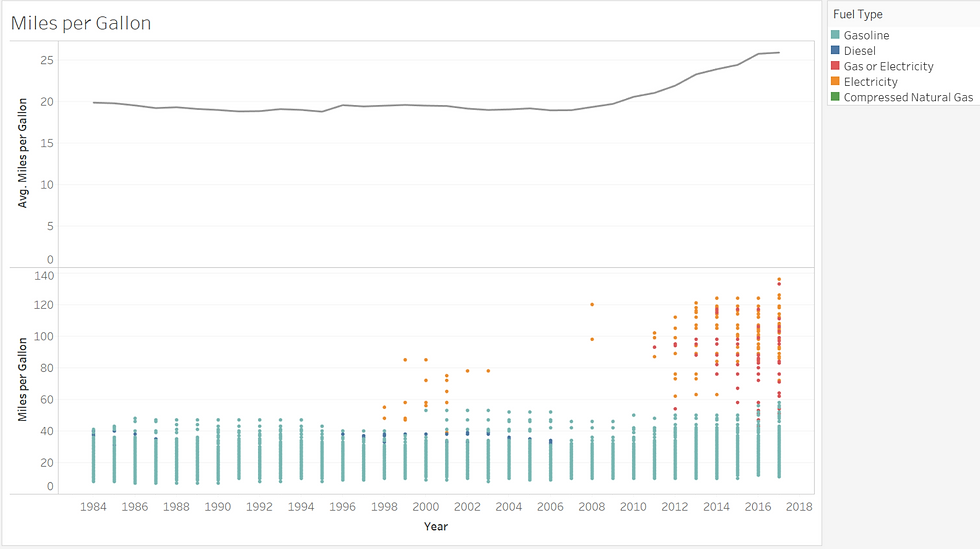Where did all these electric cars come from?
- Dane Olsen
- Oct 17, 2018
- 3 min read
For the last 100+ years, the U.S. automobile market has been dominated by fossil fueled cars. In addition to the common gas-powered vehicle, there have been diesel, propane, compressed natural gas, and even ethanol-powered vehicles, but hardly any electric vehicles. In the last seven years, however, we see a huge influx of mass manufactured electric cars. Why the sudden change?

What was happening in 1998-2003 that they were making electric cars then, and why did that stop? There were a couple in 2008 then all of a sudden in 2011, they start popping up everywhere. What’s going on here?
To magnify what was actually happening, I took the ten most efficient vehicles from each year so my information could be a little bit more focused. This is what’s showing below.

Looking for causes, I found that we had the mid-east oil embargo back in 1973. So basically, there was a war in the middle east, and it made it so we couldn’t get foreign oil. This pretty much wrecked the fossil fuel industry. There were stations all over the country that no longer had gas and it was a regularly occurring problem over several years. To offer a solution, the government created the Corporate Average Fuel Economy regulations (or CAFE). The regulations -started in 1978- mapped out until about 2010. When they say CAFE, they are talking about the fleet of each car manufacturer and what their average miles per gallon for the whole fleet needed to be. Below is a graphical representation of these regulations.

The 1992 Energy Policy Act required government fleets to have alternative fuel vehicles. In response to this, GMC came out with the EV1 (Electric Vehicle 1) six years later. It was the first mass produced all-electric vehicle in decades. A few other car manufacturers followed, but the EV1 was the best. It had a range of 60 miles and could actually go freeway speeds, both of which were impressive compared to anything else out there.
Right there in 1998, we see the orange and red dots start popping up. Below, we see how much it cost to drive those vehicles for a year for 15,000 miles. We could wonder if the production stopped because they weren't terribly efficient. Another thing is GMC said their production costs were too high on the EV1, so it wouldn’t surprise me if others had a similar story - not to mention there was not a network to charge stations for these vehicles. After 2003, electric car production stopped except for the Toyota Prius - which was introduced to the U.S. in 2000, and has maintained a strong presence even now. It was the most stable of the hybrid cars.
Besides the two random points in 2008, it doesn't pick up again until 2011.

To understand where these two came from we can refer to 2006 when The Department of Energy loaned $456 million to a group of engineers in Silicon Valley that said they could make an electric car that would have a range greater than 200 miles. This is huge compared to anything that had been seen thus far! In 2008 that group of engineers delivered with the Tesla Roadster with a range of 244 miles. The impressive thing is that Tesla survived when they came in because they came in during the great recession. New car sales in the U.S. went down by 20% from 2007 to 2008 and again to 2009 - dropping from 16 million in 2007 to 10 million in 2009.

Shortly after this, the CAFE Standards got reworked and updated. Those requirements took effect in 2011. You can see in the graph below how much the CAFE Standards were changed. In addition to that, the energy department invested $115 million in establishing electric vehicle charging stations across the country.

Lastly, the Energy department also cut the cost of batteries in half through research and development in 2013 (as demonstrated below).

Now, it seems that electric cars are fairly well established, and they will continue to be so. The interesting thing is that, once again - under the Trump administration - the CAFE standards are being looked at, and evaluated to see where they will go in the future. I am curious to see where that will take the auto industry - if we move more towards electric cars or away from them, but it looks to me like they're here to stay.


Comments